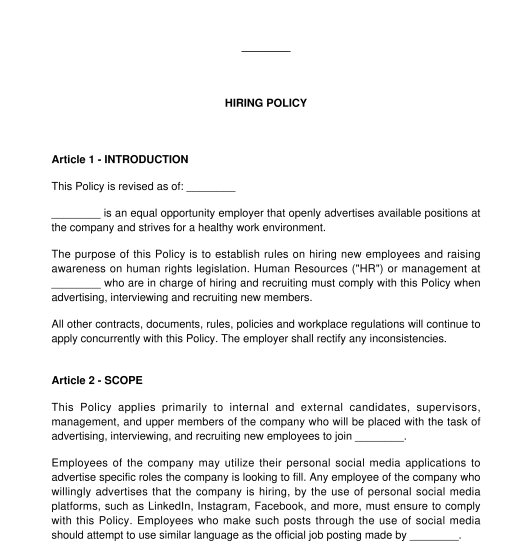 08/09/2025
08/09/2025

Answer a few questions and your document is created automatically.

Your document is ready! You will receive it in Word and PDF formats. You will be able to modify it.

A hiring policy is a document that describes an employer's hiring practices and sets rules for employees who write ads and hire for the company. The policy ensures that the employer's hiring practices are consistent with applicable human rights legislation, are fair, and promote diversity in the workplace.
No. Having a hiring policy is not mandatory, however it's an important document that outlines human rights legislation and how it applies during the hiring process. Although this Policy is not legally required, it's encouraged to have one to help prevent discrimination complaints.
Like this Hiring Policy, there are many varying workplace policies, including an Occupational Health and Safety Policy, a Vacation Policy, a Workplace Social Media Policy, a Workplace Technology Security Policy, and more.
A hiring policy should specifically address way to avoid discrimination during the recruiting process, including:
Also, the document should cover the different background checks employers conduct and how to use caution when screening employees as it needs to be consistent with human rights law.
There is no set duration of an employment policy as they normally subsist for the duration of the lifetime of the employer's organization. In other words, the duration is indefinite. However, policies must be amended to reflect the changes in legislation and should be refined to adapt to industry standards.
A hiring policy cannot contain instructions or procedures that contravene human rights legislation. For example, the policy cannot state that minority groups are excluded from the hiring process. Any violation of human rights legislation could lead to lawsuits, compensation to the injured party, and ongoing human rights training.
Once the hiring policy is ready, the employer must give it to employees. If the employer has a physical office location, keep a copy of the Policy in a conspicuous place in the event employees also have the option of going to the office. This should be placed in a communal area such as the lunch room.
Employers should include this Policy in a new employee's welcome package to ensure they are familiar with workplace protocol and avoid any future doubt that they were unaware of a specific rule or company policy.
Employees should also sign the acknowledgement at the end of the document confirming they read and understand the Hiring Policy. The employer should then add a copy of the signed Policy to each employee's file.
The process of hiring new staff raises concerns of human rights legislation. From initially advertising the position to hiring a candidate, the employer must bear in mind Federal and Provincial human rights law. The pieces of legislation per province and territory governing human rights law includes:
Ontario: Human Rights Code, R.S.O. 1990, c. H.19
Alberta: Alberta Human Rights Act, RSA 2000, c A-25.5
British Columbia: Human Rights Code, RSBC 1996, c 210
Manitoba: The Human Rights Code, CCSM c H175
Saskatchewan: The Saskatchewan Human Rights Code, 2018, SS 2018, c S-24.2
Quebec: Charter of Human Rights and Freedoms, CQLR c C-12
Nova Scotia: Human Rights Act, RSNS 1989, c 214
Prince Edward Island: Human Rights Act, RSPEI 1988, c H-12
Newfoundland and Labrador: Human Rights Act, 2010, SNL 2010, c H-13.1
Yukon: Human Rights Act, RSY 2002, c 116
Nunavut: Human Rights Act, CSNu, c H-70
Northwest Territories: Human Rights Act, SNWT 2002, c 18
New Brunswick: Human Rights Act, RSNB 2011, c 171
Canada: Canadian Human Rights Act, RSC 1985, c H-6
You fill out a form. The document is created before your eyes as you respond to the questions.
At the end, you receive it in Word and PDF formats. You can modify it and reuse it.
Hiring Policy - Template, online sample - Word and PDF
Country: Canada (English)